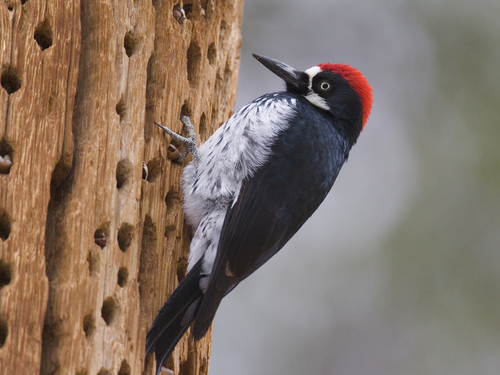
Acorn Woodpecker
The Acorn Woodpecker (Melanerpes formicivorus) is a medium-sized woodpecker notable for its unique social behavior and specialized acorn-storing habits. Unlike most woodpeckers that primarily forage for insects, Acorn Woodpeckers are highly dependent on acorns, which they store in large communal granaries. These granaries, often consisting of thousands of holes drilled into a single tree or wooden structure, are fiercely defended by family groups. This species plays a significant ecological role in oak woodland ecosystems, influencing acorn dispersal and providing habitat for other cavity-nesting birds.
19-23 cm
Length
35-43 cm
Wingspan
Least Concern
Conservation Status
Distribution
The Acorn Woodpecker is found from the northwestern United States (Oregon, California) south through Central America to Colombia. They are non-migratory, resident birds within their range, although some populations may move altitudinally in response to acorn availability.
Lifespan
Up to 17 years recorded in the wild, though the average is likely lower.
Acorn Woodpecker's Habitat
Habitat Types
Oak woodlands, Mixed coniferous-oak forests, Riparian areas with oaks
Climate Zones
Temperate, Subtropical, Tropical (at higher elevations)
Adaptations
Acorn Woodpeckers have strong, sharp claws for clinging to tree bark and a specialized tongue for extracting insects and probing for acorns. Their social structure is an adaptation to the patchy and seasonal distribution of acorns, allowing for cooperative defense of stored food resources.
Variations
Several subspecies are recognized, differing slightly in plumage and size. These variations are often linked to geographic isolation and subtle differences in habitat.
Appearance
Breeding Plumage
Plumage is generally consistent year-round.
Seasonal Feather Changes
No significant seasonal variation.
Sex Based Plumage Differences
Males have a red cap that extends to the forehead, while females have a black band separating the red cap from the white forehead.
Notable Features
Black and white patterned body with a distinctive clown-like face., Red cap (extent varies between sexes)., White forehead and throat., White patches on wings and rump, visible in flight.
Diet and Feeding
Primary Foods
Acorns, Insects, Sap, Fruit, Seeds
Foraging Behavior
Acorn Woodpeckers are primarily known for storing acorns in specially constructed granaries. They also glean insects from tree bark, flycatch, and occasionally feed on sap from sapsucker wells. They are opportunistic feeders, taking advantage of available food sources.
Specializations
Their strong bill is adapted for drilling holes in wood for acorn storage and for extracting insects. Their social system is a key specialization, allowing for efficient gathering and defense of acorns.
Seasonal Diet Variations
Acorns are a staple food year-round, but the proportion of insects in the diet increases during the breeding season when protein demands are higher for raising young.
Behavior
Social Structure
Acorn Woodpeckers live in complex family groups, often consisting of multiple breeding adults and their offspring. These groups cooperatively defend territories and maintain granaries.
Communication
A variety of calls, including a loud, raucous 'waka-waka' call., Drumming on wood surfaces., Visual displays, such as head bobbing and wing flicking.
Migration
Acorn Woodpeckers are generally non-migratory, remaining in their territories year-round. Some altitudinal movements may occur in response to acorn availability.
Territorial or Group Behaviors
Family groups are highly territorial, defending their granary trees and surrounding foraging areas from other Acorn Woodpecker groups and potential acorn thieves like squirrels and jays.
Conservation
Threats
Habitat loss (loss of oak woodlands), Sudden oak death (disease affecting oak trees), Competition with introduced species (e.g., European Starlings for nest cavities)
Protection Programs
Habitat conservation and restoration efforts focused on oak woodlands., Monitoring of populations and disease outbreaks.
Local National Laws
Protected under the Migratory Bird Treaty Act in the United States.
Population Trend
Stable
Population Estimates
Global population estimated to be around 8.5 million individuals.
Interesting Facts
Acorn Woodpeckers create granaries that can hold up to 50,000 acorns.
These granaries are essential for surviving periods of food scarcity.
They are one of the few woodpecker species known to practice cooperative breeding.
This social behavior increases the survival rate of young and the overall success of the group.
Acorn Woodpeckers have been observed using human-made structures, such as utility poles and fence posts, for storing acorns.
This demonstrates their adaptability to altered environments.
Family groups will fiercely defend their granaries.
Family groups fiercely defend these granary trees, and fights between groups can occur.
Faqs about Acorn Woodpecker
Why do Acorn Woodpeckers store acorns?
Acorns are a crucial food source, especially during winter and times of insect scarcity. Storing acorns allows them to have a reliable food supply throughout the year.
Do Acorn Woodpeckers only eat acorns?
No, they also eat insects, sap, fruit, and seeds. Acorns are a staple, but their diet is diverse.
How can I tell a male Acorn Woodpecker from a female?
Males have a red cap that extends to the forehead, while females have a black band separating the red cap from the white forehead.
Are Acorn Woodpeckers endangered?
No, they are classified as 'Least Concern' by the IUCN, meaning their populations are relatively stable.
Copyright @ Nature Style Limited. All Rights Reserved.
 English
English